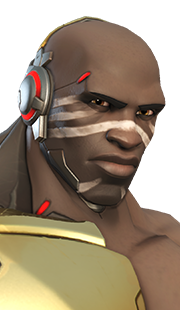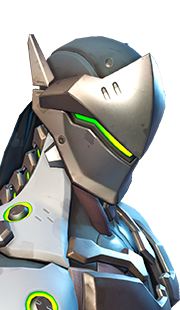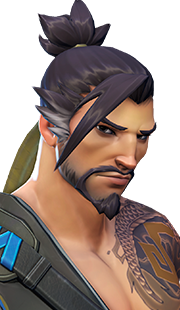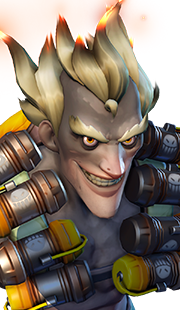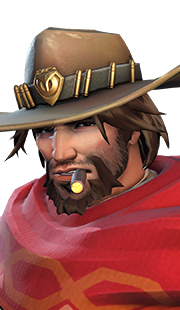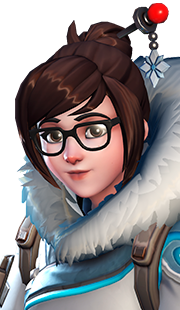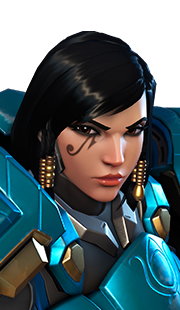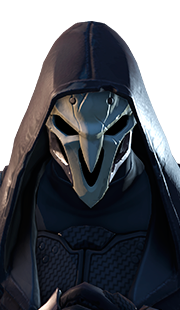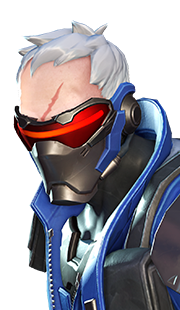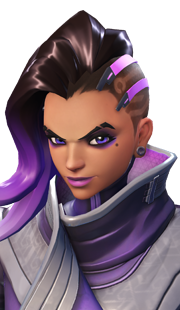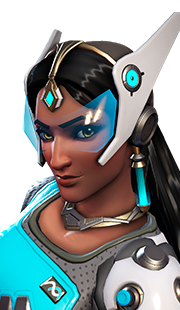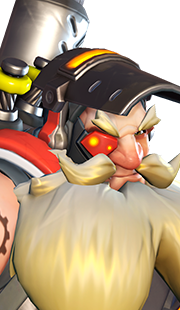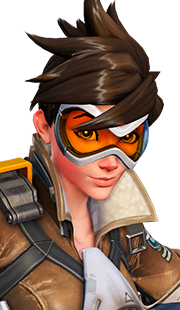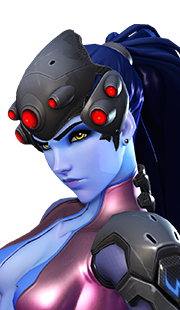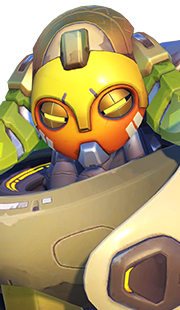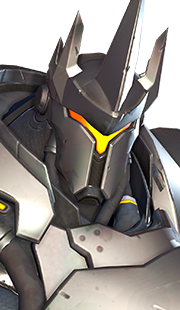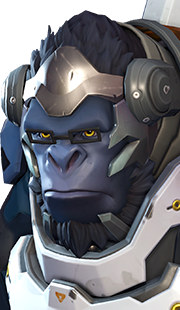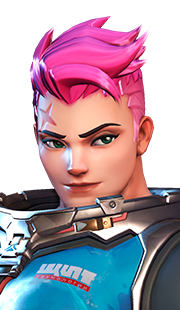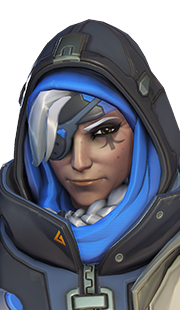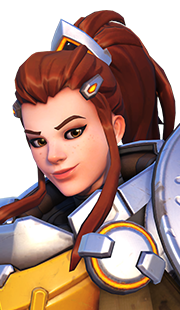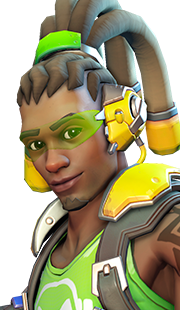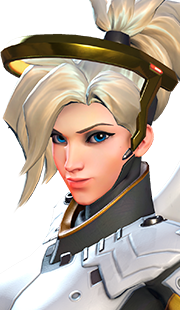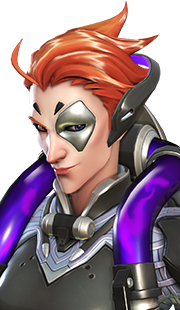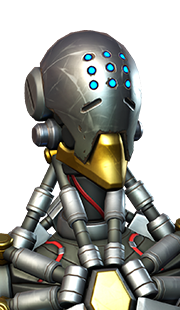Bastion Strategy & Gameplay Guide “Bleep bloop.”
Table of Contents
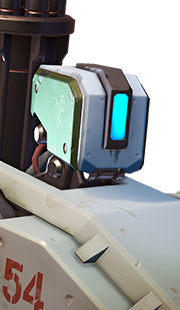
 Real Name: SST Laboratories Siege Automaton E54, "Bastion" , Age: 30
Real Name: SST Laboratories Siege Automaton E54, "Bastion" , Age: 30 Occupation: Battle Automaton
Occupation: Battle Automaton Base of Operations: Unknown
Base of Operations: Unknown Affiliation: None
Affiliation: None
This guide takes an in-depth look at how to play Bastion in Overwatch. We look at the strengths and weaknesses of the hero, and we go over mechanics, recommended strategies, and things to beware of.
The guide has been written based on our extensive experience playing the game since before the Closed Beta began, and it relies on our decades-long FPS experience. That said, our aim is to keep the guide relatively brief and easy to understand, making it accessible to veterans and new players alike.
If you have any comment on the guide's content or structure, please let us know in the comments! :)
Stamp of Approval
This guide has been reviewed and approved by KabaL, Counter Strike Legend and support player for Melty Esport Club Overwatch, one of the best teams in Europe.
Strengths
- Highest DPS and largest magazine in the game, allowing him to reliably wipe out an entire team in seconds
- Has good self-sustain thanks to
 Self-Repair
Self-Repair - Powerful ultimate (
 Configuration: Tank) that allows him to deal
large amounts of AoE damage
Configuration: Tank) that allows him to deal
large amounts of AoE damage
Weaknesses
- Is immobile while dealing his signature high damage
- Lacks movement, escape, and survival abilities, and has a large model, making him an easy target
Strategy
In this section, we will briefly go over the main strategies you should employ as Bastion. We will begin with an Overview, and then we will go in depth more about each ability that Bastion has.
Overview
Bastion is a Defense hero in Overwatch with very peculiar design. He switches between two different modes, one in which his damage is low but in which he can move around normally, and another in which he is immobile but in which he deals extremely high amounts of damage.
This second mode (![]() Configuration: Sentry) makes Bastion a very feared
hero in Overwatch. He is able to take out a full-health tank in under 2 seconds
of firing, and still have a lot of ammo left before needing to reload. In
fact, his Gatling gun has the DPS and ammo required to kill an entire enemy
team before having to reload, making Bastion an especially popular choice among
newer Overwatch players.
Configuration: Sentry) makes Bastion a very feared
hero in Overwatch. He is able to take out a full-health tank in under 2 seconds
of firing, and still have a lot of ammo left before needing to reload. In
fact, his Gatling gun has the DPS and ammo required to kill an entire enemy
team before having to reload, making Bastion an especially popular choice among
newer Overwatch players.
Indeed, despite Blizzard's repeated attempts since the start of the Beta (which have improved the situation), Bastion remains a hero that is extremely effective against newer and less experienced players, and very difficult to do well with against seasoned players.
This all has to do with Bastion's vulnerabilities, which directly shape the way he should be played. Bastion's low damage outside of Configuration: Sentry means that he wishes to minimise the time he spends outside of this configuration. This in turn means that Bastion is immobile for large amounts of time. The fact that he is stationary and extremely dangerous makes him a prime target for being flanked, shot at from a great distance, or similarly countered.
So, what does this say about exactly how you should play Bastion? Well, if you feel that the enemy team is properly equipped with dealing with you, you are better off switching to a less specialised hero. If not (or if you insist on playing as Bastion), then you will need to work together with your team to have the support and protection you need to be able to hold down crucial areas of the map in Configuration: Sentry.
Attack Versus Defense Viability
Bastion's design is such that he is much more suited to playing the defensive role. This is because he is at his strongest when he can take a protected position and wait for enemies to come to him.
When attacking, Bastion is forced to go around corners and then switch to
![]() Configuration: Sentry, fight defensive snipers at long ranges (and from
angles that he generally does not get to choose), and generally move more than
he would like. This will cause you to often be caught out in your very
vulnerable
Configuration: Sentry, fight defensive snipers at long ranges (and from
angles that he generally does not get to choose), and generally move more than
he would like. This will cause you to often be caught out in your very
vulnerable ![]() Configuration: Recon, and you will spend long amounts of time
simply running back to the battle.
Configuration: Recon, and you will spend long amounts of time
simply running back to the battle.
As a result, we advise against picking Bastion on Attack in the majority of situations. We understand that his extremely high damage output is tempting, but in most cases, offensive Bastions prove to be a liability to the team. Any Offense hero in Overwatch is better to attack with than Bastion.
Some would argue that it is viable to pick Bastion when attacking on
Payload maps, as you can set up Configuration: Sentry on top of the Payload,
and this will cause you to move forward while in your powerful Sentry
mode. This strategy is only viable if said Bastion is protected by some
combination of Reinhardt's ![]() Barrier Field, Winston's
Barrier Field, Winston's
![]() Barrier Projector, and Mercy's heals. Otherwise, this sort of
positioning on top of the objective (an objective that, we remind you,
is visible through walls) makes Bastion a top priority target; you will not
survive for long.
Barrier Projector, and Mercy's heals. Otherwise, this sort of
positioning on top of the objective (an objective that, we remind you,
is visible through walls) makes Bastion a top priority target; you will not
survive for long.
Another popular time to pick Bastion on Attack is when the defenders have set up strong positions right outside the spawn point of the attackers. Here, it is said, Bastion can help to quickly wipe out the defenders. While this may work at times, it is also a sub-optimal strategy. Enemy snipers will easily take you out from long range, and your Configuration: Sentry does not offer you the required survivability or long range damage to stay out in the open and take out the defenders. In this situation, an Offense hero that can backstab the defenders (such as Reaper, Tracer, or Genji), or even a tank, would prove much more effective.
At the risk of repeating ourselves, we say again that picking Bastion on Offense is crippling to your team.
That said, if you are playing in a team with several people you know and with whom you are communicating, you can form fairly strong synergies with heroes such as Symmetra (for shields), Torbjörn (for armor), as well as with the above-mentioned Mercy, Reinhardt, and Winston. Aside from this, if your team consists of mostly mobile attacking heroes that can push the enemies back and leave the objective relatively open, Bastion can work well to secure the objective and keep it safe from lone enemy heroes.
Finally, on Control maps, we also feel that Bastion is a poor choice, although not as bad as on Payload, Point Capture, or Hybrid maps. The very close range nature of the points on Control maps, coupled with the many obstacles that allow players to break line of sight, make it easy for Bastion to be flanked and backstabbed without having been able to deliver his high damage. Staying at a distance off the point is also a bad idea, as you cannot contribute to capturing or contesting the point, and players on the point can generally take cover and hide from you anyway.
Abilities
Reconfigure
Switch between weapon configuration.
![]() Reconfigure is an ability that Bastion uses to switch freely
between his two configurations,
Reconfigure is an ability that Bastion uses to switch freely
between his two configurations, ![]() Configuration: Recon and
Configuration: Recon and
![]() Configuration: Sentry.
Configuration: Sentry.
There is no cost or cooldown associated with this ability, but it does have a short cast time. Switching from between configurations takes 0.5 seconds, and doing so instantly reloads your weapon.
There is nothing more to say about this ability except that you will use it freely to achieve the goals we describe in the rest of the guide.
Configuration: Recon
Mobile with a light automatic weapon.
Bastion's default stance is ![]() Configuration: Recon. In this stance,
Bastion is able to move around freely like any other hero (although his
movement speed is not very high), which he uses for running back after dying,
and for repositioning during or after combat.
Configuration: Recon. In this stance,
Bastion is able to move around freely like any other hero (although his
movement speed is not very high), which he uses for running back after dying,
and for repositioning during or after combat.
In this Configuration, Bastion is equipped with a weak submachine gun. Its damage capabilities at close and medium range are decent (although it has a small magazine, and if you hold down the fire button, the accuracy will go down, so you are encouraged to fire in bursts), but at higher ranges it suffers not only from bad accuracy when spraying, but also from damage drop-off.
All in all, fighting enemies in Configuration: Recon is not advised. Unless
your plan is to retreat from the fight, you are probably better off going into
![]() Configuration: Sentry and eliminating your enemy right away. That said,
if you run into excellent close range heroes like Reaper or
McCree, it does not really matter what you do as you will not
survive.
Configuration: Sentry and eliminating your enemy right away. That said,
if you run into excellent close range heroes like Reaper or
McCree, it does not really matter what you do as you will not
survive.
Configuration: Recon's submachine gun is useful for taking out
Symmetra ![]() Sentry Turrets or
Sentry Turrets or ![]() Teleporters, or
Junkrat traps.
Teleporters, or
Junkrat traps.
Configuration: Sentry
Immobile with a powerful rotary cannon.
![]() Configuration: Sentry is what Bastion is all about. In this mode,
Bastion cannot move or jump, and he is instead immobile at the location where
he enters the Configuration. While in Configuration: Sentry, Bastion can turn
in a 360 degree radius, and he can also look up and down.
Configuration: Sentry is what Bastion is all about. In this mode,
Bastion cannot move or jump, and he is instead immobile at the location where
he enters the Configuration. While in Configuration: Sentry, Bastion can turn
in a 360 degree radius, and he can also look up and down.
His submachine gun turns into a powerful Gatling gun with 200 ammo, which is capable of dealing extreme amounts of damage. If you hold down primary fire, the accuracy does decrease, but this effect is not great and it is only noticeable at high ranges. In addition to this, there is damage drop-off at range, meaning that past a certain point, Bastion is not very effective (he cannot, for example, fight an enemy Widowmaker at very long range from a position of equality).
Finally, Bastion has a weak spot on his back (a power core), which effectively work as a "head" (as he has no head hitbox in this Configuration). Damage dealt to this spot is doubled.
Configuration: Sentry is how Bastion is meant to be played, as outside of this Configuration he is extremely underwhelming. The idea is to position yourself somewhere safe, go into Configuration: Sentry, and wait for the attackers to come to you. The narrower and more predictable the path that the attackers have to take to get to you, the better.
As for actually shooting, it is generally a simple question of holding down
primary fire. As tempting as putting down suppressing fire to keep the enemy
from even showing themselves is, you always want to be mindful of how many
bullets you have left. If you need to reload, it is more time-efficient to use
![]() Reconfigure to go into Configuration: Recon and then back into Sentry
than to simply reload. When doing this, you can also take the opportunity to
reposition yourself slightly, if it is appropriate.
Reconfigure to go into Configuration: Recon and then back into Sentry
than to simply reload. When doing this, you can also take the opportunity to
reposition yourself slightly, if it is appropriate.
While in Configuration: Sentry, you have to always be aware of just how vulnerable you are to the other team. This should lead you to developing several habits.
- While reloading, and whenever no enemies are in your general line of sight, take the time to turn around and scan for anyone attempting to flank you.
- Once your position has been revealed to most of the enemy team (or even to
one enemy, if you think they are communicating well among them), take the
first opportunity to
 Reconfigure and change location.
Reconfigure and change location. - If the enemy team has heroes capable of long range combat (snipers, Pharah), do not expose yourself to long ranges.
- Try, as much as possible, to set up with your back to walls or corners, to protect yourself from backstabs.
One other useful thing to keep in mind is that you can activate Configuration: Sentry while you are flying, jumping, or falling. This allows you to sneak up to a high point behind the enemy team (ideally by walking in crouch so that the enemies cannot hear you), jump down and activate your Configuration: Sentry while in the air for a quick surprise attack. Even if you do not necessarily use the jumping part, you can sometimes just sneak up on the enemy team, enter Configuration: Sentry, and take them all by surprise.
Perhaps most importantly, we would argue, is to know when Bastion is no longer a viable choice in your game. Once you have lost the element of surprise, and when the other team has one or more heroes dedicated to hunting and taking you out, it is time to switch hero. This is especially true if you notice a highly skilled Tracer or Genji coming for you time and time again.
Self-Repair
Hold to heal yourself.
![]() Self-Repair is a channeled ability that heals Bastion for 25% of
his total health every second. If Bastion takes damage while channeling
Self-Repair, then the ability is interrupted and it goes on a 1-second
cooldown. Self-Repair can be used in any configuration (including
Self-Repair is a channeled ability that heals Bastion for 25% of
his total health every second. If Bastion takes damage while channeling
Self-Repair, then the ability is interrupted and it goes on a 1-second
cooldown. Self-Repair can be used in any configuration (including
![]() Configuration: Tank, your ultimate).
Configuration: Tank, your ultimate).
Self-Repair does not do anything to increase Bastion's in-combat survivability, but it does help him remain somewhat autonomous throughout the game. It especially helps with his poor mobility, as getting to health packs is not really feasible most of the time.
You should use Self-Repair to top off your health whenever there are no
enemies shooting at you. If you are in ![]() Configuration: Recon, then you
should take cover first before doing so.
Configuration: Recon, then you
should take cover first before doing so.
Configuration: Tank
- Ultimate
Mobile with a powerful cannon.
Bastion's ultimate turns him into a powerful mobile tank for 8 seconds. During this time, Bastion's attacks deal very high damage, which also splashes to nearby targets. He also gains 150 armor, increasing his survivability somewhat.
Configuration: Tank takes Bastion's very high damage and adds mobility and survivability to it, allowing him to wreak havoc among an attacking team, while surviving long enough to do so.
Configuration: Tank has a 1-second casting time, Bastion's rate of fire during it is 1 per second (meaning he will shoot a maximum of 8 cannonballs), and his movement speed is quite low.
There are two uses for Configuration: Tank.
The first is to deal large amounts of damage. This is its primary use, and the one you should mostly look towards. Given that the duration of your ultimate is rather short, and that you deal splash damage, it is best served when there are multiple enemies to hit. In general, we would advise you to save your ultimate for when you feel that your team needs the extra boost in damage. For example, if all 5 of your teammates are alive and defending the point, do not waste your ultimate against 1 or 2 attackers; instead, wait until you notice a more coordinate attack, or until one or two of your teammates have been killed.
Of particular importance is dealing with an enemy Reinhardt's
![]() Barrier Field. If you spot this, instead of simply activating your
ultimate and trying to destroy it, you should instead first shoot the shield
down in
Barrier Field. If you spot this, instead of simply activating your
ultimate and trying to destroy it, you should instead first shoot the shield
down in ![]() Configuration: Sentry. This will be very quick, and you will then
be able to deal your massive AoE Configuration: Tank damage with ease.
Otherwise, the shield will absorb all of your cannonballs without breaking.
Configuration: Sentry. This will be very quick, and you will then
be able to deal your massive AoE Configuration: Tank damage with ease.
Otherwise, the shield will absorb all of your cannonballs without breaking.
The second use for your ultimate is to prevent you from dying. If your situation looks hopeless, activating Configuration: Tank can save you and allow you to kill the heroes that were attacking you. Just keep in mind the casting time of the ability.
One very interesting trick you can use during Configuration: Tank is to perform rocket jumps. By aiming your crosshair at the ground beneath you and shooting, you can propel yourself a good distance in the air. This allows you to get to surprising areas from which to attack your enemies. You can see a short video of KabaL using this technique here.
Notable Counters and Vulnerabilities
Because of Bastion's peculiar design and his very marked weaknesses, we feel that it is important to point out heroes and situations are most dangerous to you.
Backstabbing
The most common way of getting killed as Bastion is having sneaky enemy heroes come up behind you and kill you before you have a chance to turn around and shoot at them.
The most common heroes to do this are Tracer and Genji, but Reaper is also sometimes responsible.
Tracer can use her ![]() Blink to quickly end up behind you,
and she can deal great damage to your core before you even have a chance to
react. Her Blink and
Blink to quickly end up behind you,
and she can deal great damage to your core before you even have a chance to
react. Her Blink and ![]() Recall allow her to usually get away unhurt
even if you do notice her in time.
Recall allow her to usually get away unhurt
even if you do notice her in time.
Genji's entire kit allows him to take you out with ease. His
![]() Cyber-Agility allows him to get to you no matter where you are, and
he can then easily attack you from behind. Even if you do turn around in
time, he can block incoming damage (and hurt or kill you in the process)
with
Cyber-Agility allows him to get to you no matter where you are, and
he can then easily attack you from behind. Even if you do turn around in
time, he can block incoming damage (and hurt or kill you in the process)
with ![]() Deflect, and he can damage and confuse you, or escape with
Deflect, and he can damage and confuse you, or escape with
![]() Swift Strike.
Swift Strike.
Against these two heroes, your best chances are to take a position that is as much up against a wall as possible (ideally in a corner), with no area above you from where you can be attacked. Fortunately, both of these heroes have very low health, so if you notice them early enough, you can shred them to pieces with your Gatling gun (but again, beware of Genji's Deflect).
Reaper is much slower, so getting to you is more difficult for him. The
main way in which he will do it is through ![]() Shadow Step, so try to be
on the look-out for the animation that announces his arrival (if you see it,
simply pre-fire the location and you will kill him). Otherwise, whenever you
notice him, react and try to kill him as quickly as possible. At the very
least, you can hope to have him retreat with
Shadow Step, so try to be
on the look-out for the animation that announces his arrival (if you see it,
simply pre-fire the location and you will kill him). Otherwise, whenever you
notice him, react and try to kill him as quickly as possible. At the very
least, you can hope to have him retreat with ![]() Wraith Form.
Wraith Form.
That said, however, if the enemy team has competent players, you stand no chance of surviving as Bastion without the help of your teammates, so your best protection is being surrounded by your team. Even then, however, you are not fully safe from a brave Tracer or Genji.
Snipers
Enemy Widowmakers and Hanzos do very well against you, because your damage is not effective at very long ranges. Widowmaker can kill you in 2 fully-charged shots, and she needs to only be exposed to you for a very brief moment to shoot them. Hanzo deals slightly less damage than her, but the same applies.
Against these two heroes, as well as against a Pharah firing rockets
at you from afar, you are extremely vulnerable. Pharah's rockets are slow, so
avoiding them is normally easy, but it is not possible for you to do in
![]() Configuration: Sentry. Your best chance is not to expose yourself out in
the open. Try to take angles that do not allow you to be shot at from more than
medium range.
Configuration: Sentry. Your best chance is not to expose yourself out in
the open. Try to take angles that do not allow you to be shot at from more than
medium range.
Symmetra and Reinhardt
Symmetra is a very strong counter to Bastion, due to her
![]() Photon Projector orbs. These orbs deal extremely high damage to all
enemies in their path, but they move very slowly. Normally, like
Pharah's rockets, they can be avoided, but your
Photon Projector orbs. These orbs deal extremely high damage to all
enemies in their path, but they move very slowly. Normally, like
Pharah's rockets, they can be avoided, but your
![]() Configuration: Sentry prevents you from doing so. It is possible for you
to quickly
Configuration: Sentry prevents you from doing so. It is possible for you
to quickly ![]() Reconfigure and dodge them, but doing so disrupts your
positioning (and she can keep shooting them at you constantly).
Reconfigure and dodge them, but doing so disrupts your
positioning (and she can keep shooting them at you constantly).
Your greatest hope is that the enemy team will not have a Symmetra, as she is not a popular choice on Attack (for good reason). If there is a Symmetra on the other team, then simply take protected angles that prevent her from facing you to fire her orbs.
Reinhardt also has a good counter to Bastion in the form of his
![]() Fire Strike ability, which works similarly to Symmetra's (deals damage
to all enemies in its path, moves slowly). Fortunately for you, the cooldown
on Fire Strike means that you will have time to regain some health before it
can be used again, but it still a reliable means to damage you from afar. The
same applies as to dealing with Symmetra: simply take defensive angles.
Fire Strike ability, which works similarly to Symmetra's (deals damage
to all enemies in its path, moves slowly). Fortunately for you, the cooldown
on Fire Strike means that you will have time to regain some health before it
can be used again, but it still a reliable means to damage you from afar. The
same applies as to dealing with Symmetra: simply take defensive angles.
Moreover, Reinhardt's ![]() Charge, if used from a close range
(before you have a chance to react and kill him) can be devastating to
Bastion.
Charge, if used from a close range
(before you have a chance to react and kill him) can be devastating to
Bastion.
Junkrat
Junkrat can easily spam his grenades at your location without exposing himself to you (or to your teammates), and this will quickly kill you. To counter this, you need to pick areas where grenades are difficult to bounce to you, and of course you need your team's help in keeping enemy Junkrats away.
Changelog
- 17 May 2016: Made several updates following KabaL's review.
- Added some exceptions for when an attacking Bastion can work.
- Added emphasis to the usefulness of using Reconfigure to reload your weapon.
- Added some mentions of how Bastion can sneak up behind enemies and go into Configuration: Sentry.
- Added Junkrat as a counter.
- Added mention of using rocket jump during Configuration: Tank, as well as a paragraph about dealing with Reinhardt's shield.
- 05 May 2016: Guide added.
- Blizzard at Gamescom 2024
- Icy Veins Seeking Writers for Zenless Zone Zero: Apply Today!
- No BlizzCon in 2024
- Blizzard Games Return to China: New Agreement Signed With NetEase
- Blizzard Reportedly Reuniting with NetEase to Bring Back WoW in China
- Ex-Activision Blizzard CEO Bobby Kotick Shows Interest in Buying TikTok
- Timeline of Blizzard Presidents
- Johanna Faires Appointed Blizzard Entertainment President
